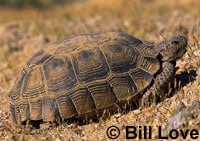I recently read an article about how U.S. Fish and Wildlife officers were called in to remove ravens from the campus of Copper Mountain College in Jos
I recently read an article about how U.S. Fish and Wildlife officers were called in to remove ravens from the campus of Copper Mountain College in Joshua Tree, Calif., because the birds were killing baby desert tortoises (Gopherus agassizii). Curse those birds! Baby tortoises are especially vulnerable to predators because their shells have yet to harden. Until they do they’re almost like softshell crabs…their shells don’t offer much protection (but let me admit, I love softshell crab poboys). It takes a few years for young desert tortoise shells to harden.

Photo by Bill Love
Desert tortoise (Gopherus agassizii)
I’ve found wild desert tortoises in Joshua Tree before, as the place is only a couple hours from where I live. I’ll never forget my first herping trip there, as it was not only the first time I saw a desert tortoise in the wild, it was the first time I saw desert iguanas in the wild. Desert iguanas remain one of my all-time favorite lizards. Maybe someday I’ll write about Iguanadon, my pet desert iguana, and my wild desert iguana encounters. Or maybe I already have. To tell you the truth it’s getting a little difficult sometimes for me to remember what I’ve rambled on about in my blog.
Regardless, the first desert tortoise I ever found in the wild was a very little one, only a few months old. I found it not in the open desert but in the backyard of a friend’s cabin, bulldozing its way around the desert scrub. It fit snugly into the palm of my hand, and I was very tempted to take it home with me. That being illegal, however, I opted not to. Hopefully that tortoise is still out there, bigger, robust and not being attacked by ravens.
Wild desert tortoises have a lot to concern them. Off-roaders have been known to run them over; predation, of course; removal from the wild by people who want to keep them as pets; and disease. The latter is especially significant in regard to California desert tortoise populations. A respiratory disease has run rampant through desert tortoise populations over the past several years. The theory is that it resulted when people released their pet desert tortoises back into the wild. Here we had people who probably thought they were doing right by their tortoises, only to unleash widespread disease — yet another reason why you should never release your pet reptiles into the wild.
Oddly, for pet tortoise enthusiasts, this situation has something of an upside to it. Because it is illegal to release pet desert tortoises into the wild, people who no longer want their tortoises will often turn them over to a tortoise rescue. Tortoise rescues will then offer the tortoises up for adoption. Many will query you about the type of home you could provide a tortoise. I think they generally frown on homes with pools that a tortoise could fall into, or dogs that could chew on them, etc. But if you’ve got the right kind of place you’ve got a good chance of adopting a tortoise.
When I was younger and living with my family we had two good-sized desert tortoises in the backyard. They were named Geraldine and Goliath. They would hibernate during the winter and it was always a fun time when we had our first tortoise spotting in the spring. They grazed in the yard – sometimes ate Mom’s flowers, which she probably didn’t appreciate too much – and were just generally great to have around. We moved from that house and the people who were moving in after us agreed to keep Geraldine and Goliath. I wonder if they’re still there.
I had a small desert tortoise at the house where I’m living now. Sadly, I came home one day to discover that someone had stepped on it and crushed the shell, which resulted in the tortoise’s death. Upon talking to yard guys and family members, nobody ever fessed up to it. Maybe they didn’t realize they had done so. There’s a portion of my backyard that is covered with rocks, and if someone was walking in it and the tortoise was there, too, I could see how someone might step on the tortoise and not know it. Anyway, that was a major bummer. I have since contemplated getting some new tortoises – bigger ones, preferably, so the “stepping-on” risk would be nullified. The other option is to contain them in a pen.
If you live in an area that is hospitable to keeping desert tortoises outside and there are rescues nearby from which you can adopt some, consider doing so. There are tortoises out there that need homes and they do make very personable pets. I remember one day a friend and I were hanging out in my backyard when my tortoise appeared from around the far corner of the house. We watched him approach all the way over to where we were sitting, heading with determination for my friend’s bare feet. Just as he was saying, “Do you think he would bite my toes?” the tortoise stretched his head out, mouth open and ready to sample my friend’s big toe. He jerked backward as if it was a rattler about to bite him and not a small desert tortoise. It was really funny.



